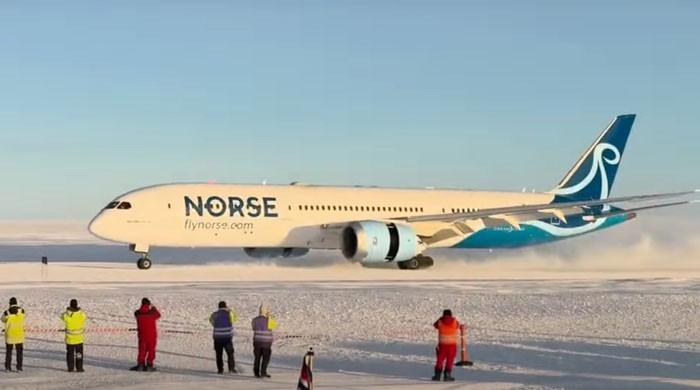Norse Atlantic Airways made aviation history as the first airline to successfully land a Boeing 787 Dreamliner on the icy terrain of Antarctica. The journey which commenced on November 13, 2023, saw the Dreamliner take off from Oslo, making a stop in Cape Town before the leg of its expedition to the sixth continent.

Also Read: SpaceX Gets FAA Approval for Second Test Launch of Starship
The Dreamliner named Everglades touched down at Troll Airfield on November 15, a historic moment for both Norse Atlantic Airways and the aviation industry at large.
This achievement lies not only in the successful landing of a large passenger aircraft in Antarctica but also in holding for advancing scientific research and logistical operations in the region.
The blue ice runway at Troll Airfield, spanning 3,000 meters in length and 60 meters in width, provided a landing strip for the Dreamliner.
This runway, carved from the snow and ice, presented a challenging platform for the skilled pilots and crew to navigate. The landing took place in bright sunlight, as it is currently summer in the southern hemisphere.
The Dreamliner, known for its design capable of carrying up to 330 passengers, was chosen for its ample cargo space and fuel efficiency.
The aircraft, operated by Norse Atlantic Airways, carried 45 passengers, including scientists from the Norwegian Polar Institute, and 12 tons of research equipment destined for the Troll research station in Queen Maud Land, Antarctica.
Daniel Carey of Aircontact, the broker facilitating the flight, addressed the Dreamliner’s suitability for the mission, citing its cargo capacity and fuel efficiency.
Also Read: Scientists Discover Oldest Black Hole Formed 470 Million Years After Big Bang
Paul Erlandsson a field service representative at Boeing, highlighted the aircraft’s ability to complete the round-trip journey from Cape Town to Antarctica without the need for refueling.
The decision to utilize a larger aircraft for this mission aligns with the Norwegian Polar Institute’s commitment to sustainability.
Camilla Brekke, the institute’s director, addressed the environmental benefits of using large and modern aircraft, stating that it can contribute to reducing overall emissions and the environmental footprint in Antarctica.
“Landing such a large aircraft opens up entirely new possibilities for logistics at Troll, which will also contribute to strengthening Norwegian research in Antarctica,” said Brekke.
The logistical challenges of operating in Antarctica are well-known, with limited infrastructure, challenging weather conditions.
The success of this mission is the capability of the Dreamliner but also opens up new avenues for logistics in the region.
While the landing has got global attention, there is no indication of commercial flights to Antarctica in the near future.
The focus remains on improving logistics to support scientific research, with the Norwegian Polar Institute arranging up to 10 flights of varying sizes to the continent each year.
Also Read: Kilonova Explosion Could End Life on Earth for 1,000 Years
The video footage of the Dreamliner’s landing at Troll Airfield showcases the smooth nature of the operation, a testament to the expertise of the pilots reliability of the Boeing aircraft.
The achievement has been celebrated by Norse Atlantic Airways, with CEO Bjorn Tore Larsen expressing pride and honor in being part of this moment.
The decision to utilize the Boeing 787 Dreamliner for this Antarctic expedition was not arbitrary. The aircraft’s ample cargo space and fuel efficiency played roles in its selection.
Daniel Carey of Aircontact, the broker overseeing the flight, addressed the Dreamliner’s suitability for transporting both passengers and cargo efficiently. The aircraft completed the round-trip journey from Cape Town to Antarctica without the need for refueling.
Camilla Brekke, Director of the Norwegian Polar Institute, highlighted the environmental benefits of employing larger and more modern aircraft for Antarctic logistics.
By reducing overall emissions and the environmental footprint, this innovative approach opens up new possibilities for supporting research activities in Antarctica.
John Guldahl, Logistics Director of the Norwegian Polar Institute, addressed the collaborative aspect of the mission, with passengers from several countries onboard heading to different research stations.
The possibility of collaboration opens up new avenues for scientific exchange among nations involved in Antarctic research.
Also Read: Rats have the Power to Imagine, Research Reveals























